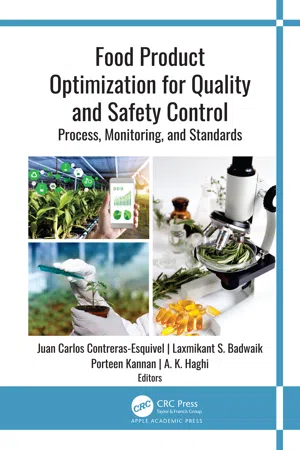
Food Product Optimization for Quality and Safety Control
Process, Monitoring, and Standards
- 396 pages
- English
- ePUB (mobile friendly)
- Available on iOS & Android
Food Product Optimization for Quality and Safety Control
Process, Monitoring, and Standards
About this book
This new book discusses food quality and safety standards that are critically important for both developed and developing economies, where consumer safety is among the primary issues to be considered in food supply chain management. The editors consider that food safety is a multi-faceted subject, using microbiology, chemistry, standards and regulations, and risk management to address issues involving bacterial pathogens, chemical contaminants, natural toxicants, additive safety, allergens, and more; hence, the volume emphasizes the interrelationship between these areas and their equal importance in food production.With chapters from researchers from around the world, this book looks at critically important advances and topics in technology that has become indispensable in controlling hazards in the modern food industry. The varied topics include the role of mineral content of soils in food safety, microwaveassisted extraction of phenolic compounds, foodborne pathogenic anaerobes, enzymatic modification of ferulic acid content, and more.
Frequently asked questions
- Essential is ideal for learners and professionals who enjoy exploring a wide range of subjects. Access the Essential Library with 800,000+ trusted titles and best-sellers across business, personal growth, and the humanities. Includes unlimited reading time and Standard Read Aloud voice.
- Complete: Perfect for advanced learners and researchers needing full, unrestricted access. Unlock 1.4M+ books across hundreds of subjects, including academic and specialized titles. The Complete Plan also includes advanced features like Premium Read Aloud and Research Assistant.
Please note we cannot support devices running on iOS 13 and Android 7 or earlier. Learn more about using the app.
Information
CHAPTER 1
Transformation of Phosphorus in Soils of Agroecosystems in Long-Term Experiments: Sustainability Challenges of Phosphorus and Food
ABSTRACT
1.1 INTRODUCTION
1.2 METHODS
1.3 DISCUSSION
Table of contents
- Cover
- Half Page
- Title Page
- Copyright Page
- About the Editors
- Contents
- Contributors
- Abbreviations
- Preface
- 1. Transformation of Phosphorus in Soils of Agroecosystems in Long-Term Experiments: Sustainability Challenges of Phosphorus and Food
- 2. The Content of Exchange Potassium in Soil with Prolonged Application of Fertilizers: Impact of Soil on Food Safety
- 3. Foodborne Pathogenic Anaerobes
- 4. Microwave-Assisted Extraction of Phenolic Compounds from Ceylon Olive (Elaeocarpus serratus)
- 5. Surfactant-Mediated Ultrasound-Assisted Extraction of Phenolic Compounds from Musa balbisiana Bracts: Kinetic Study and Phytochemical Profiling
- 6. Current Prospects of Bio-Based Nanostructured Materials in Food Safety and Preservation
- 7. Campylobacteriosis: Emerging Foodborne Zoonosis
- 8. Enzymatic Modification of Ferulic Acid Content in Arabinoxylans from Maize Distillers Grains: Effect on Gels Rheology
- 9. Stability and Quality of Fruit Juices Incorporated with Probiotic Lactobacilli
- 10. Enthalpy‑Entropy Compensation and Adsorption Characteristics of Legumes Using ANN Modeling
- 11. Enzymatic Production of Chito‑Oligosaccharides and D‑glucosamine by Fungal Chitosanases from Aspergillus spp.: A Review
- 12. Isomaltulose: The Next Sweetener, A Quick Review
- 13. Going Through Pulsed Electric Field Technology for Food Processing: Assessment of Progress and Achievements
- 14. Security and Biodisponibility of Derivatives from Medicinal Plants in Food Consumption
- 15. Dough Viscoelasticity of the Bread‑Making Process Using Dynamic Oscillation Method: A Review
- 16. Physicochemical Characteristics and Gelling Properties of Arabinoxylans Recovered from Maize Wastewater: Effect of Lime Soaking Time During Nixtamalization
- Index